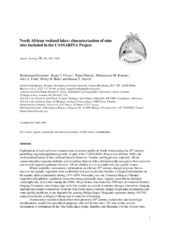North African wetland lakes: characterization of nine sites included in the CASSARINA Project
Ramdani, Mohammed; Flower, Roger J.; Elkhiati, Najat; Kraïem, Mohammed M.; Fathi, Adel A.; Birks, Hilary H.; Patrick, Simon T.
Peer reviewed, Journal article
Permanent lenke
https://hdl.handle.net/1956/2510Utgivelsesdato
2001Metadata
Vis full innførselSamlinger
Originalversjon
https://doi.org/10.1023/a:1011957324901Sammendrag
Exploitation of land and water resources has increased rapidly in North Africa during the 20th century, paralleling regional population growth. As part of the CASSARINA Project (see Flower, 2001), the environmental status of nine wetland lakes in Morocco, Tunisia, and Egypt was evaluated. All are conservationally important habitats and several are Ramsar Sites (internationally recognized bird reserves) and several support significant fisheries. All are shallow (<2 m in depth) but vary greatly in area. Where available, documentary information on relevant 20th century changes is given. Survey transects for aquatic vegetation were established and used to provide baseline ecological information on the aquatic plant communities during 1997–1999. Unusually, one site (Tunisian Megene Chitane) supported acidophilous vegetation (some taxa being nationally rare). Aquatic macrophytes declined catastrophically at two sites during the 1990s. Merja Bokka was drained in 1998 and, at Garaet El Ichkeul, fringing Phragmites and Scirpus spp. were lost, mainly as a result of salinity changes. Elsewhere, fringing macrophytes remain (extensively so in the Nile Delta lakes) common, despite major land reclamation and water quality problems, or are degraded by grazing (Merja Zerga). Marginal vegetation during 1997/98 changed markedly at Megene Chitane due to water level lowering. Documentary records indicated that throughout the 20th century, reclamation and hydrologic modifications, mainly for agricultural purposes, affected all nine sites. The loss of lake area by reclamation is substantial for the Nile Delta lakes (Edku, Burullus and Manzala). For the western sites, some data indicate increasing salinity in the most recent decade but the Delta lakes have become generally fresher during the 20th century, as supply of Nile water for irrigation increased. Despite intense human disturbance, many of the remaining CASSARINA sites still support regions of high aquatic diversity. Spatial scale monitoring of the larger sites for seasonal and inter-annual changes in open water area and in aquatic plant abundances is a key requirement for integrated environmental change assessment in the 21st century.
